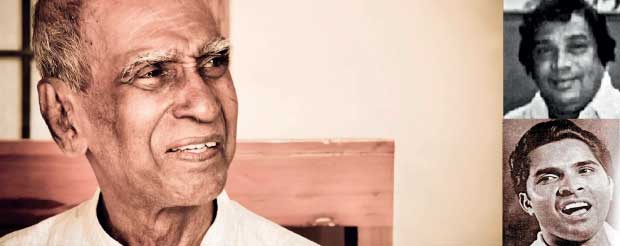Reply To:
Name - Reply Comment
Last Updated : 2024-04-19 00:03:00

“Past the near meadows, over the
still stream,
Up the hill-side; and now ’tis buried deep
In the next valley-glades:
Was it a vision, or a waking dream?
Fled is that music: –
Do I wake or sleep?”
~John Keats, Ode to a Nightingale
Quintus Horatius Flaccus known in the English-speaking world as Horace was the leading Roman lyric poet during the time of Augustus.Contemplative about art in general and painting in particular, he is recorded to have said as follows: “A picture is a poem without words”. A song well rendered by a master is “a drama enacted without a depiction”.
 Amaradeva’s every song belongs in that rare category. It is not an easy task to talk about Amaradeva and his unmatched contribution to the Sinhalese culture and art without referencing the times and events of his era and his peers, if any, and other artists who happen to crowd a fairly challenging field. Amaradeva entered the field of music and song at a time when the standards of singing and music were deplorable. It was either Nadagam or dramatic style singing and straight copies from India, both Northern and southern. The singers too, except a very few like Devar Surya Sena and Ananda Samarakoon, were of South Indian origin. They wrote the lyrics in Tamil and sang out in Sinhala. What a travesty of culture!
Amaradeva’s every song belongs in that rare category. It is not an easy task to talk about Amaradeva and his unmatched contribution to the Sinhalese culture and art without referencing the times and events of his era and his peers, if any, and other artists who happen to crowd a fairly challenging field. Amaradeva entered the field of music and song at a time when the standards of singing and music were deplorable. It was either Nadagam or dramatic style singing and straight copies from India, both Northern and southern. The singers too, except a very few like Devar Surya Sena and Ananda Samarakoon, were of South Indian origin. They wrote the lyrics in Tamil and sang out in Sinhala. What a travesty of culture!
The socio-cultural environment that prevailed at the time did demand a pioneering voice, so to speak, to speak out, to throw away the rut and furrow of Sinhala-pretenders whose allegiance was not to a new culture of Sinhala song and music, but to a livelihood that earned them an income far below the level of their brethren in India, yet bragged that they were the pioneers of Sinhalese music and song. The backdrop was wretched yet hopeful and dreaming. It was dotted with scarce emergence of one or two genuine sounding artists who had the misfortune of disappearing from the milieu of the art for lack of listener-following and sponsors. Ananda Samarakoon was one such pioneer who made a very valiant effort at creating a tradition of Sinhalese art of music and song, yet he fell far short of a ‘pioneering’ character.
It was into this scene Amaradeva set his footsteps as Albert Perera. His voice was without match; his discipline of rendering a tune without breaking a single note and his attention to the minutest detail of lyrics and melody was coolly secured and deeply rooted in the construction of the totality of the song. Such discipline and attention to detail in the industry at the time was absent.
With the initiation of Albert Perera, another artist of superior value and quality stamped his own creed on the scene of art and culture. That was Professor Ediriweera Sarachchandra. Considered Sri Lanka’s premier playwright, he was a senior lecturer at the University of Peradeniya. His influence on Amaradeva, including changing the very persona from Albert Perera to Amaradeva, was fundamental and the subsequent rise of Amaradeva as the leading singing voice of Ceylon a logical evolution.Not only of the singer-musician Amaradeva but the expansion of Sri Lankan folk cum indigenous music and song was inevitable.
From thereon, Amaradeva not only broadened the horizon of local music, he dominated the panorama of music and song. Addition of another unique artist Sri Lanka was fortunate to be blessed with, Mahagama Sekera, into the Amaradeva saga. That also engendered the blossoming of the thereto veiled talents and skills of contemporaneous lyricists/poets such as Sri Chandraratne Manawasinghe, Siri Gunasinghe, Madawala S. Ratnayake, Lucian Bulathsinghala and subsequently Sunil Ariyaratne.
Sunil Santha not only possessed a rich and melodious voice; his unpretentious melodies provided some of the most sung-along songs of any artist of our generation.
The contribution of Mahagama Sekera to Amaradeva’s development as a complete singer cannot be overstated. Madhuwanthi, a radio programme Amaradeva and Sekera took part in in the Radio Ceylon, as Sri Lankan Broadcasting Corporation was called then, produced some of the most magnificent lyrical and musical creations of all time. Sannaliyane (weavers’ song), Ase Mathuwena Kandulu Bindu Gena (tribute to Avukana Buddha Statue), Kanda Udin Ena Gomariye, Patu Adahas Nam Pawurin Lokaya (a song from Tagore’s Gitanjali ), Paalu Anduru Nil Ahasa Mamai, Mala Hiru Basina Henda Yaame are a collection of unsurpassed creations in the field of Sinhala music and song.
Of the trio of Amaradeva, Sekera and Sarachchandra, Sekera is the ‘ultimate artist’, in that, Sekera’s accomplishments in the fields of lyric writing, poetry, painting, as a playwright, film director are consummate and quintessential. The trio of Amaradeva, Sekera and Chithrasena produced the best five to seven minutes of Sinhala art and drama in the dramatization of Étha Kandukara Himavu Arane song, which most critics consider as Amaradeva’s best song, with both Chithrasena and Vajira dancing to the sublime tune and steps so splendidly trained and superlatively performed. That is an occasion on which all three artists conjured and fashioned a jewel of a creation on stage. Yet again, in Chithrasena’s Karadiya play, Amaradeva’s voice haunted in ‘Hoiya Hooiya’, a soulful rendition of the tough and sorrowful life of fishermen.
The list is endless. Madawala Ratnayake’s Ruwanmalee, a melancholy weeping for the village damsel who fell victim to the waters of the nearby river; even a weeping tribute to a maiden, Nil Maanel Mal Pipuna, unquestionably one of the most heart wrenching odes, one intertwined with a religious shade. One of Amaradeva’s last songs, Giman Harina Diyamba Dige, a soothing melody harmonized so enchantingly and taking the listener to another dimension of existence has not departed from the Amaradeva touch, yet finding a different terrain of entertainment. The magical way in which Amaradeva could detain an audience in a prison of spellbound silence and grip it in an enthralled trance was no accident. And no other artist had that talent, nor had the discipline to master such talent.
Amaradeva had many imitators but none came close to the mastery of voice, the near-infinite expanse of the timber of that voice or the magnificent array of lyrical talents that surrounded him right throughout his career spanning more than six decades. In pure technique of singing no singer could match him, not Sunil Edirisinghe or Amarasiri Peiris, not Sanath Nandasiri or Victor Rantayake or Edward Jayakody.
Only two artistes I would dare to compare with the Master. One is Sunil Santha; the other is H. R. Jothipala. Sunil Santha not only possessed a rich and melodious voice; his unpretentious melodies provided some of the most sung-along songs of any artist of our generation; it has continued to enchant thousands of avid listeners for many more decades. Jothipala is a different kettle of fish altogether. Most of Jothipala’s songs were copies from Hindi songs; his lyricists did not bother to delve into the nuanced sentiments of life; his music directors made a bad attempt at imitating the music from Hindi musicians, sometimes with a little bit of success and others with gross failure. Yet Jothipala’s voice was unique and his control of the note and timber of voice bordered on perfection.
Unfortunately ‘Jothi’ who represented ‘popular culture’ and arguably was,in technique, our ‘best singer’, never sang a ‘good’ song! Such an oxymoron fitted Jothipala’s genre. Both Amaradeva and Sunil Santha had imitators who could sing just like them; but Jothipala had no imitators. No singer could imitate Jothipala’s voice. In the pure technique of singing, he could match Amaradeva. No argument.
Yet Amaradeva stands alone atop a mount of highly talented singers. What made Amaradeva apart was not only his singing skills; the lyrics and music that accompanied the deep and reverberating voice which was once haunting and another time possessed a sweet melancholy, belonged to a rustic artist who was very much at peace with himself and his creations. When one hears Pilé Padura Hénata Aragena Enawa, the forlorn environ the song creates in the heart and mind of the listener is breathtaking. Amaradeva’s songs were a painting with numerous abstract meanings while at the same time would take the fortunate to the land of artistic euphoria.
In my book of Greats Modern Artists of Sri Lanka, I would include the following: Mahagama Sekera, Ediriweera Sarachchandra, Lester James Peiris, Joe Abeywickrema and last but not least, Amaradeva. In their own respective fields, they did not have equals.
On November 3, 2016 - one year ago - Amaradeva closed his eyes for the last time. The songs that cascaded from his lips forgot to take leave with him. A true national treasure, Amaradeva will live with us as long as Sinhala music and song see their last. American Nobel laureate William Faulkner wrote thus: “The aim of every artist is to arrest motion, which is life, by artificial means and hold it fixed so that a hundred years later, when a stranger looks at it, it moves again since it is life.” Amaradeva was such an artist. Future generations would look at life and feel that ‘arrested life’ and shall pass the purest of pure joy on to the next.
The writer can be contacted at vishwamithra1984@gmail.com

Add comment
Comments will be edited (grammar, spelling and slang) and authorized at the discretion of Daily Mirror online. The website also has the right not to publish selected comments.
Reply To:
Name - Reply Comment
On March 26, a couple arriving from Thailand was arrested with 88 live animal
According to villagers from Naula-Moragolla out of 105 families 80 can afford
Is the situation in Sri Lanka so grim that locals harbour hope that they coul
A recent post on social media revealed that three purple-faced langurs near t

10 Apr 2024
09 Apr 2024